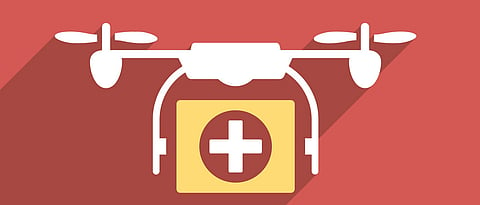

In India, every time a harvested organ is to be transported from one hospital to the other, the police create a green corridor. By this arrangement, the route to be taken by the ambulance transporting the organ is cleared of other traffic, so the ambulance passes through it without any hindrance. Hence, the ambulance can cover the route to the hospital in the shortest time possible. This arrangement has worked wonders and many organs have been delivered safely and on time and then transplanted on the recipient.
However, with the advancement in technology, it may not be necessary to create a green corridor. The organ that is harvested could be transported by a drone from the hospital where the donor is admitted to where the transplant is going to take place.
Recently, for the first time, a kidney that was harvested from a donor was transported to the hospital where the recipient was admitted by a drone in the USA.
This took place at Baltimore, a port city in the state of Maryland, USA. The drone developers told CNN that unmanned aircraft delivery could become the fastest, safest and least expensive method for delivering transplant organs.
The unmanned aviation system was developed by a team comprising physicians, researchers and aviation and engineering experts from the University of Maryland School of Medicine, the University of Maryland and the Living Legacy Foundation of Maryland, an NGO that works for organ transplantation.
According to experts, the faster an organ is transplanted after harvesting, the better is the function.
The team that did the transportation first carried out test flights that transported saline, blood tubes and other medical material and then transported the healthy kidney. According to CNN, the effort included many technological firsts, including designing special equipment for maintaining and monitoring a human organ on the custom-built unmanned aircraft system. Safeguards included backup propellers and motors, dual batteries, a backup power distribution board and a parachute recovery system, in case the entire aircraft fails.
The Baltimore Sun said it took more than three years efforts to ensure that unmanned aircraft can safely transport life-saving organs and tissue.
The effort began when transplant surgeon Dr Joseph Scalea, frustrated by slow pace of commercial flights and high cost of charters, began exploring faster means of delivering kidneys, livers and other organs that can quickly deteriorate.
Dr Scalea and engineering and aviation experts had designed a cooler with sensors for monitoring the organs by cellphone. He said drones could cut down travel time for the farthest deliveries by 70 per cent. The Baltimore Sun said the organ was flown 4.1 km in 10 minutes, which takes 15-20 minutes by car depending on traffic.
As done in Baltimore, in India, work could start with drones ferrying medical supplies. Drones could soon get crucial medical supplies to patients in need. To begin with, drones could transport organs within the city.
Experts say the drones should be engine-powered to travel across the country and should be capable of avoiding collision with obstacles.
